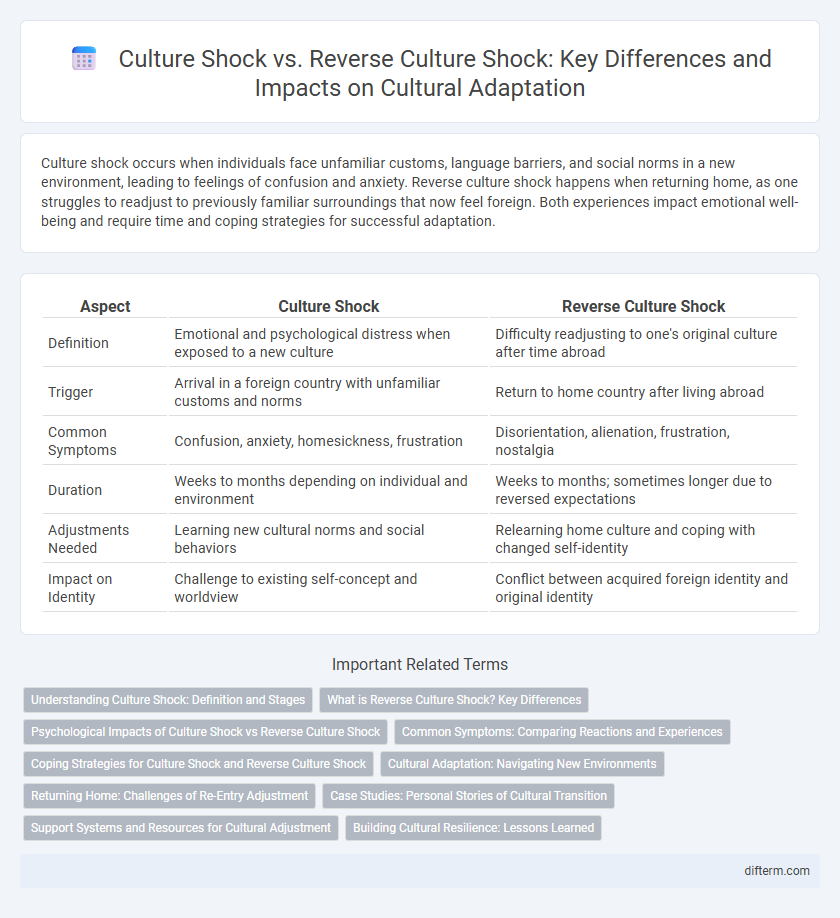Culture shock occurs when individuals face unfamiliar customs, language barriers, and social norms in a new environment, leading to feelings of confusion and anxiety. Reverse culture shock happens when returning home, as one struggles to readjust to previously familiar surroundings that now feel foreign. Both experiences impact emotional well-being and require time and coping strategies for successful adaptation.
Table of Comparison
| Aspect | Culture Shock | Reverse Culture Shock |
|---|---|---|
| Definition | Emotional and psychological distress when exposed to a new culture | Difficulty readjusting to one's original culture after time abroad |
| Trigger | Arrival in a foreign country with unfamiliar customs and norms | Return to home country after living abroad |
| Common Symptoms | Confusion, anxiety, homesickness, frustration | Disorientation, alienation, frustration, nostalgia |
| Duration | Weeks to months depending on individual and environment | Weeks to months; sometimes longer due to reversed expectations |
| Adjustments Needed | Learning new cultural norms and social behaviors | Relearning home culture and coping with changed self-identity |
| Impact on Identity | Challenge to existing self-concept and worldview | Conflict between acquired foreign identity and original identity |
Understanding Culture Shock: Definition and Stages
Culture shock is the psychological discomfort experienced when encountering a new cultural environment, typically progressing through stages of honeymoon, frustration, adjustment, and acceptance. Reverse culture shock occurs when returning to one's home culture after an extended period abroad, often causing feelings of alienation and difficulty reintegrating. Recognizing these stages helps individuals prepare for emotional responses and develop coping strategies during cross-cultural transitions.
What is Reverse Culture Shock? Key Differences
Reverse culture shock occurs when individuals return to their home country and experience difficulty readjusting due to significant changes in their cultural environment during their absence. Unlike culture shock, which involves initial adaptation challenges in a new foreign setting, reverse culture shock results from unmet expectations and feelings of disconnection upon reentry. Key differences include emotional responses; culture shock often involves anxiety and excitement, whereas reverse culture shock features frustration and alienation as familiar environments suddenly feel unfamiliar.
Psychological Impacts of Culture Shock vs Reverse Culture Shock
Culture shock often causes anxiety, disorientation, and stress as individuals adjust to unfamiliar social norms and environments, leading to feelings of isolation and frustration. Reverse culture shock triggers a similar psychological impact but can be more complex, including identity confusion and difficulty reintegrating into one's original culture after adapting to a new one. Both phenomena involve emotional upheaval, but reverse culture shock may also provoke nostalgia and loss, complicating the psychological adjustment process.
Common Symptoms: Comparing Reactions and Experiences
Culture shock often manifests through symptoms like anxiety, disorientation, and homesickness as individuals adjust to unfamiliar environments, while reverse culture shock triggers similar emotional responses such as frustration, alienation, and difficulty readjusting to one's home culture. Both experiences involve psychological and physical symptoms including irritability, insomnia, and mood swings, reflecting the stress of adapting to different cultural contexts. Understanding these common reactions aids in developing coping strategies and support mechanisms for smoother cultural transitions.
Coping Strategies for Culture Shock and Reverse Culture Shock
Effective coping strategies for culture shock include maintaining open communication, seeking social support from locals or fellow expatriates, and engaging in cultural activities to foster understanding and adaptation. For reverse culture shock, focusing on self-reflection, reconnecting with familiar traditions, and sharing experiences with friends and family can ease the transition back home. Professional counseling and expatriate support groups also provide valuable resources to manage emotional challenges during both cultural adjustments.
Cultural Adaptation: Navigating New Environments
Cultural adaptation involves adjusting to unfamiliar norms, values, and social behaviors when experiencing culture shock in a new environment. Reverse culture shock occurs when returning to one's home culture, where individuals may struggle with reintegration due to changed perspectives and expectations. Effective navigation of both experiences requires developing cultural intelligence, resilience, and open-mindedness to bridge contrasting cultural frameworks.
Returning Home: Challenges of Re-Entry Adjustment
Returning home after extended time abroad often triggers reverse culture shock, where individuals face unexpected difficulties readjusting to familiar environments. Challenges include altered personal identities, shifting social dynamics, and contrasting lifestyle expectations compared to the host culture. Effective re-entry adjustment requires awareness of these emotional and psychological impacts to facilitate smoother reintegration into one's native culture.
Case Studies: Personal Stories of Cultural Transition
Case studies of culture shock reveal individuals grappling with disorientation and anxiety when adapting to unfamiliar social norms and customs in foreign environments. Conversely, reverse culture shock emerges in personal narratives as returning expatriates face unexpected challenges reintegrating into their home culture, highlighting feelings of alienation and cultural dissonance. These stories emphasize emotional and psychological impacts, demonstrating the complexities of cultural transition beyond initial adaptation.
Support Systems and Resources for Cultural Adjustment
Effective support systems such as counseling services, cultural orientation programs, and peer support groups play a crucial role in mitigating both culture shock and reverse culture shock by providing essential resources for emotional and psychological adjustment. Access to language assistance, social networks, and educational workshops enhances individuals' ability to navigate cultural transitions smoothly. Continuous engagement with these resources fosters resilience and helps maintain a balanced cultural identity during reintegration phases.
Building Cultural Resilience: Lessons Learned
Building cultural resilience involves recognizing the emotional challenges of culture shock and reverse culture shock to develop adaptive coping strategies. Exposure to diverse cultural environments enhances intercultural competence, fostering flexibility and open-mindedness essential for reintegration into one's home culture. Reflecting on personal experiences and seeking social support are critical steps in transforming culture shock into growth opportunities and reinforcing cultural resilience.
culture shock vs reverse culture shock Infographic

 difterm.com
difterm.com